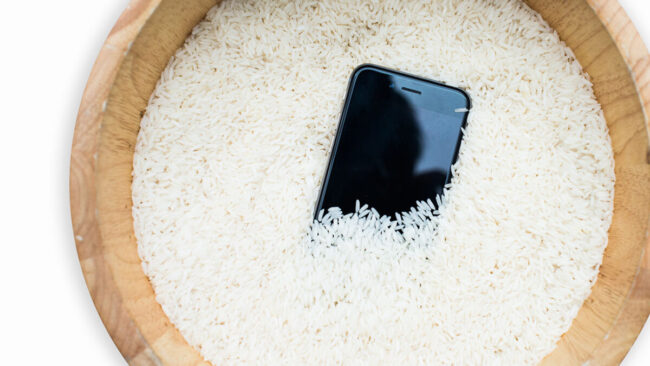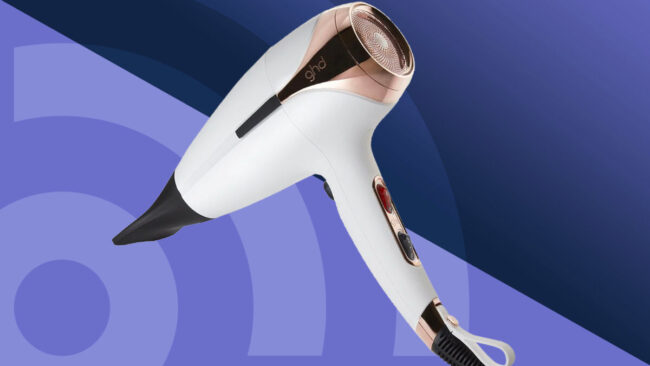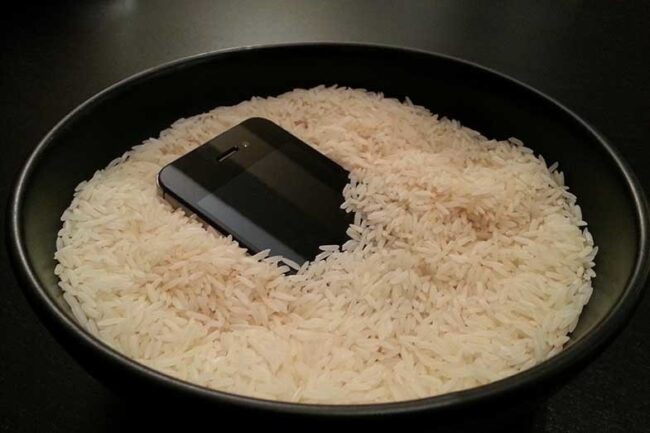Spilling water on your iPhone or dropping it in a puddle can feel like a nightmare. The common advice to immediately put your water-damaged iPhone in a bowl of rice has been around for ages. But does it really work, or is it just a myth that gives us false hope? Let’s dive into the details and see if rice is the hero or if it’s just a sidekick in the quest to save your phone.
The origin of the rice method

The rice method has become almost instinctive for many when their phone gets wet. It’s a go-to piece of advice passed down from friends and family, often accompanied by anecdotes of miraculous recoveries. The idea is that uncooked rice can absorb moisture from the phone, drying it out and preventing damage. But how did this advice become so popular? It likely gained traction because rice is a common household item and seems to provide an immediate solution to an urgent problem.
How rice supposedly works
The theory behind using rice is pretty straightforward. Rice is a desiccant, meaning it can absorb moisture from the environment. When you submerge your water-damaged iPhone in a bowl of rice, the grains are supposed to draw out the moisture from inside your device, helping it to dry out faster than it would on its own. It sounds plausible because rice is known for absorbing water when cooked, so it makes sense to assume it would do the same in this scenario.
The limitations of rice
While the rice method seems like a good idea, there are several reasons why it might not be as effective as people think:
Ineffectiveness at deep drying. Rice can absorb some surface moisture, but it’s not efficient at reaching the water trapped deep inside your iPhone. Components like the motherboard and internal circuits are not easily accessible to rice grains.
Slow absorption rate. Rice doesn’t absorb moisture quickly. It takes a long time to make a significant impact, and in the crucial first hours after water exposure, the slow absorption rate of rice might not be fast enough to prevent damage.
Debris and dust. Rice can leave behind dust and small particles that might get stuck in your phone’s ports and crevices, potentially causing more harm than good.
False sense of security. Believing that rice will definitely save your phone can delay you from taking more effective measures, such as using proper drying techniques or seeking professional help.
Better alternatives

Instead of relying on rice, consider these more effective methods to save your water-damaged iPhone:
Silica gel packets. These are the small packets often found in new shoe boxes and electronic packaging. They are designed to absorb moisture and are more effective than rice. If you have them on hand, place your phone in a sealed container with several silica gel packets.
Vacuum sealing. If you have access to a vacuum sealer, use it to create a low-humidity environment for your phone. This can help draw out moisture more effectively than rice.
Professional drying kits. There are specialized drying kits available for electronics that include powerful desiccants. These kits are designed specifically to absorb moisture from devices like smartphones.
Natural air drying. Simply leaving your phone in a well-ventilated area with good airflow can be effective. Placing it in front of a fan or near an open window can help speed up the drying process.
Immediate steps after water exposure
Regardless of the drying method you choose, it’s important to take immediate steps after your phone gets wet:
- Turn the device down immediately to prevent short circuits.
- Remove accessories – take off any cases, and remove the SIM card.
- Use a soft cloth to gently dry the exterior of the phone.
- Avoid heat – do not use a hairdryer or microwave (high heat can damage the internal components of your phone).
- Consider contacting technicians capable of repairing the device in case the damage has been done already – iFIX New York experts can help you if the issue is beyond any DIY attempts.
Myths and Misconceptions

There are plenty of myths and misconceptions that can lead you astray.
Hairdryers and Heat
Using a hairdryer or other heat sources might seem like a good idea, but it can actually cause more harm than good. Excessive heat can damage the internal components of your iPhone and make the situation worse. The intense heat can warp the delicate circuitry and lead to permanent damage. Moreover, blowing air can push water further into the device, exacerbating the problem.
Freezing Your iPhone
Some suggest putting your iPhone in the freezer to “freeze” the water and then remove it. This method is not recommended, as it can cause condensation inside the device when it warms up again, leading to more water damage. Freezing can also cause the screen and other components to become brittle and crack. Additionally, the expansion of water as it freezes can cause internal damage to the phone’s structure.
When to Seek Professional Help
Sometimes, despite your best efforts, your iPhone may still exhibit signs of water damage that you can’t fix on your own. Knowing when to call in the experts can save you time, money, and further frustration.
Persistent Issues
If your iPhone still doesn’t work correctly after attempting these methods, it might be time to seek professional help. Persistent issues like screen flickering, unresponsive buttons, or poor battery performance could indicate deeper damage. Ignoring these signs can lead to more severe problems down the line. A professional technician can diagnose the exact issue and provide a more permanent solution.
Warranty and AppleCare
Check your warranty or AppleCare status. If your iPhone is covered, you might be eligible for a repair or replacement at a reduced cost. Keep in mind that water damage isn’t always covered, so it’s best to check the specifics of your policy. Make sure to document the incident and any steps you took to mitigate the damage. This information can be helpful when discussing your case with Apple support or a service provider.
Conclusion

The rice method for saving a water-damaged iPhone has become a popular piece of advice, but it’s not the most effective solution. While it can absorb some moisture, it’s slow and doesn’t reach the internal components of your device. Alternatives like silica gel packets, vacuum sealing, and professional drying kits offer better chances of saving your phone.
Keep in mind – acting quickly and using the right methods can make all the difference. So next time your iPhone takes an unexpected dip, you might want to skip the rice and opt for more reliable solutions.
